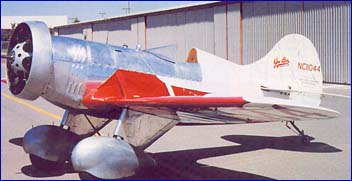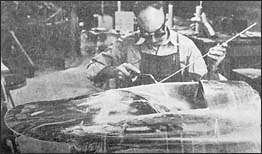Aluminum Oxy-Fuel Welding with
Fuels and Metal Filler Selection Chart
Aluminum Welding
Using Oxy-Fuel Welding on Aircraft Aluminum Sheet
from Experimenter Magazine, April 1996
See TM Technologies
Aluminum Gas Welding System
HISTORY

We'll begin with a brief history of related welding processes, in order to present Oxy-fuel welding in context. The heliarc (GTAW) was discovered in November of 1942, and by 1946, together with wire-feed (GMAW), helped pioneer the application of new exotic, materials vital to supersonic flight. However, for nearly half a century prior and half a century since, the common oxy-fuel torch has been a significant mainstay in the aluminum joining process.
In the 1850s, metals of low melting points such as gold, silver, copper, and platinum, first began to be torch welded using oxy-hydrogen produced by electrolysis. Of special note is the fact that acetylene's discovery was directly associated with the search for another method of producing aluminum metal, and that both materials finally came into commercial production in the late1800s.
The chief advantages of OFW over GTAW are economy, speed, penetration, workability, and small flat weld beads requiring minimal dressing. Disadvantages are flux cleanup, large HAZ, and that fewer alloys lend themselves well to the process.
Torch brazing (or braze welding) will not be considered here, as it by definition does not melt the parent metal, but rather joins by surface adhesion of the melted filler metal. Also avoided will be the flea-market 3-in-1 pot metal rods, and various Lumi-braze zinc-bearing materials used chiefly for repairing cheap die-cast parts. One common failure of these items occurs when aluminum sheet so joined is planished, and the subsequent cracks arch observant eyebrows. Note: areas erroneously joined in this fashion must be completely removed or the infection will be spread by attempted fixes.
|
Fahrenheit degrees Fuel Gas |
Combustion Ratio Oxygen to Fuel Gas |
Flame Temp Oxy-Fuel |
|
Acetylene |
2.5 |
5590 |
|
Propane |
5.0 |
4580 |
|
MAPP |
4.0 |
5300 |
|
Natural Gas |
2.0 |
4600 |
|
Hydrogen |
0.5 |
4820 |
FUELS
Oxy-hydrogen more than oxy-acetylene, is traditionally associated with OFW in the aircraft industry, but not because of any technical advantage. Due to wartime economics, acetylene was rationed specifically for shipyard use, leaving hydrogen the only other choice.
The fuel chart shown above indicates only part of the significant oxy-fuel heat difference between hydrogen and acetylene. Suffice it to say, acetylene is much hotter. The choice of hydrogen as a fuel necessitates a completely separate tank, regulator, hose, and torch, because mixing acetylene residues with hydrogen gas invites explosive disaster. Further, hydrogen is not capable of producing soot, which can be used beneficially as a temperature indicator for the annealing process on aluminum sheet. The benefits of hydrogen may be fuel production cost (if an electrolysis plant is feasible), and a slightly cleaner weld zone appearance, due to the absence of carbon in the flame.

Metal Filler Selection Chart
|
Base Metals |
1100 3003 |
5005 |
5052 |
5086 |
6061 |
|
6061 |
4043(A) 4047 |
4043(A) 5183 5356 5554(D) 5556 5654(C) |
5356 5183 5554 5556 5654(C) 4043(A) |
5356 5183 5556 |
4043(A) 4047 5183 5654(C) 5554(D) 5556 5356 |
|
5086 |
5356 4043(A) |
5356 5183 5556 |
5356 5183 5556 |
5356 5183 5556 |
|
|
5052 |
5183 5356 5556 4043(A) (B) |
4043(A) 5183 5356 5556 4047 |
5654(C) 5183 5356 5554(D) 5556 4043 |
||
|
5005 |
5183 5356 5556 4043(A) (B) |
5183 5356 5556 4043(A) (B) |
|||
|
1100 3003 |
1100 4043(A) |
Note: Listed in order of increasing strength: 5356, 5183, 5556.
4047 has more Si than 4043, therefore less sensitivity to hot cracking, slightly higher weld shear strength and less ductility.
(A) 4043, because of its Si content, is less susceptible to hot cracking, but has less weld ductility and may crack when planished.
(B) For applications at sustained temperatures above 150 degrees F. because of intergranular corrosion.
(C) Low temperature service @ 150 degrees F. and below
(D) 5554 is suitable for elevated temperatures.
Continue



